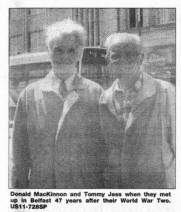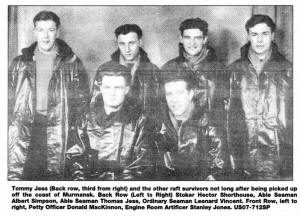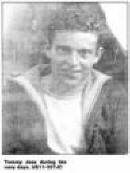220 ON BOARD AND ONLY 61 SURVIVED GERMAN STRIKE
STORY by JULIE SPENCE
 |
 |
EVERY March 20th brings vivid memories of lost friends flooding back to old sailor Tommy Jess.
But this Sunday will be particularly poignant for the Lisburn man, because it will be the 60th anniversary of the day his ship was sunk by a German submarine in the freezing Barents Sea, taking the lives of 158 of his friends and shipmates.
Tommy was hailed a hero when he returned to Dromore in 1945 after surviving the torpedo attack, but the 83-year-old can still recall clearly the hours following the attack and the struggle for survival on a life raft in the icy sea.
Before the war he worked at Mackey's engineering company in Belfast and whilst the staff were out on strike one of his colleagues suggested enlisting as something to do to ease the boredom.
While his friends joined the army and air force, Tommy was the only one to join the navy for one simple reason -he liked the uniform!
"During the strike one fella suggested going to Clifton Street to sign up and I was the only one who joined the navy. I liked the idea of it and the uniform was attractive. The ladies used to rub our collar because it was supposed to be good luck!" he recalled.
Tommy left his family behind in 1942 and began his naval training. He came home to Dromore on leave several times and always found it hard to go away again.
"Many times I came home and wished I wasn't going back because I knew what I was going back to" he said.
In 1944 Tommy was on board one of the ships which
escorted the American troops to Omaha Beach for the D-Day
invasion. "We saw a lot of action and a lot of bodies too," Tommy simply said.
a lot of action and a lot of bodies too," Tommy simply said.
After surviving the horrors of the D-Day landings, little did he know that a greater horror was yet to come.
After D-Day his ship, HMS Lapwing, became part of the Russian Convoy, escorting ships through the treacherous, submarine-invested waters off the Russian coast.
The Lapwing left Greenock on its last voyage into Russian waters on March 11, 1945 and at 10.58am on March 20 a German submarine torpedoed the ship, knocking the captain unconscious.
Tommy recalls: "We knew there were submarines in the area but we didn't think it would happen to us. When the torpedo hit I was blown about 10 yards down the deck and all I had was skinned knuckles. We got the order 'every man for himself' and in less than ten minutes there was no ship left."
Tommy and some of his ship mates managed to climb onto a life raft. He remembers watching the ship vanish into the icy waters and feared that they would all be dragged under with it.
"The raft was attached to the ship with a rope. We were so scared that we would be pulled down. I was the only one with a knife so I got it out and cut the rope."
Over the next two hours, Tommy drifted in and out of consciousness. He remembers 16 people on the raft but by the time they were rescued only six remained.
"It was snowing and I remember seeing the rescue boat coming through the haze but I blacked out just after that and don't remember being rescued. "Our worst enemy was the weather. Some of the men had been clinging to a rope on the raft and their hands had frozen around the rope so they had to break their fingers. It was an awful experience."
The survivors from HMS Lapwing were rescued two hours later by HMS Savage. Once on board the survivors were examined by the ship's doctor, who said they would only have survived another 20 minutes in the freezing conditions. In a bid to bring them round they were put under hot showers and as Tommy recalls: "They poured brandy down our throats.
Before returning home, the six survivors had their photograph taken, a poignant reminder of the trauma they endured together. The six then parted company.
For forty years Tommy continued on with his life at home, until one day in 1992 his wife took a phone call he had never expected to receive.
"I was out bowling when Donald MacKinnon called to say he
was in Northern Ireland and would I like to meet up,"
explained Tommy.
Donald was one of the other survivors who had clung to that
life raft. The pair agreed to meet up in Belfast and have
rekindled their friendship, remaining in regular contact
ever since.
The 60th anniversary of the sinking of HMS Lapwing is on March 20, this Sunday, when Tommy and the other survivors will take time to remember the hundreds of men who did not see their homes again.
Ulster Star
18/03/2005

